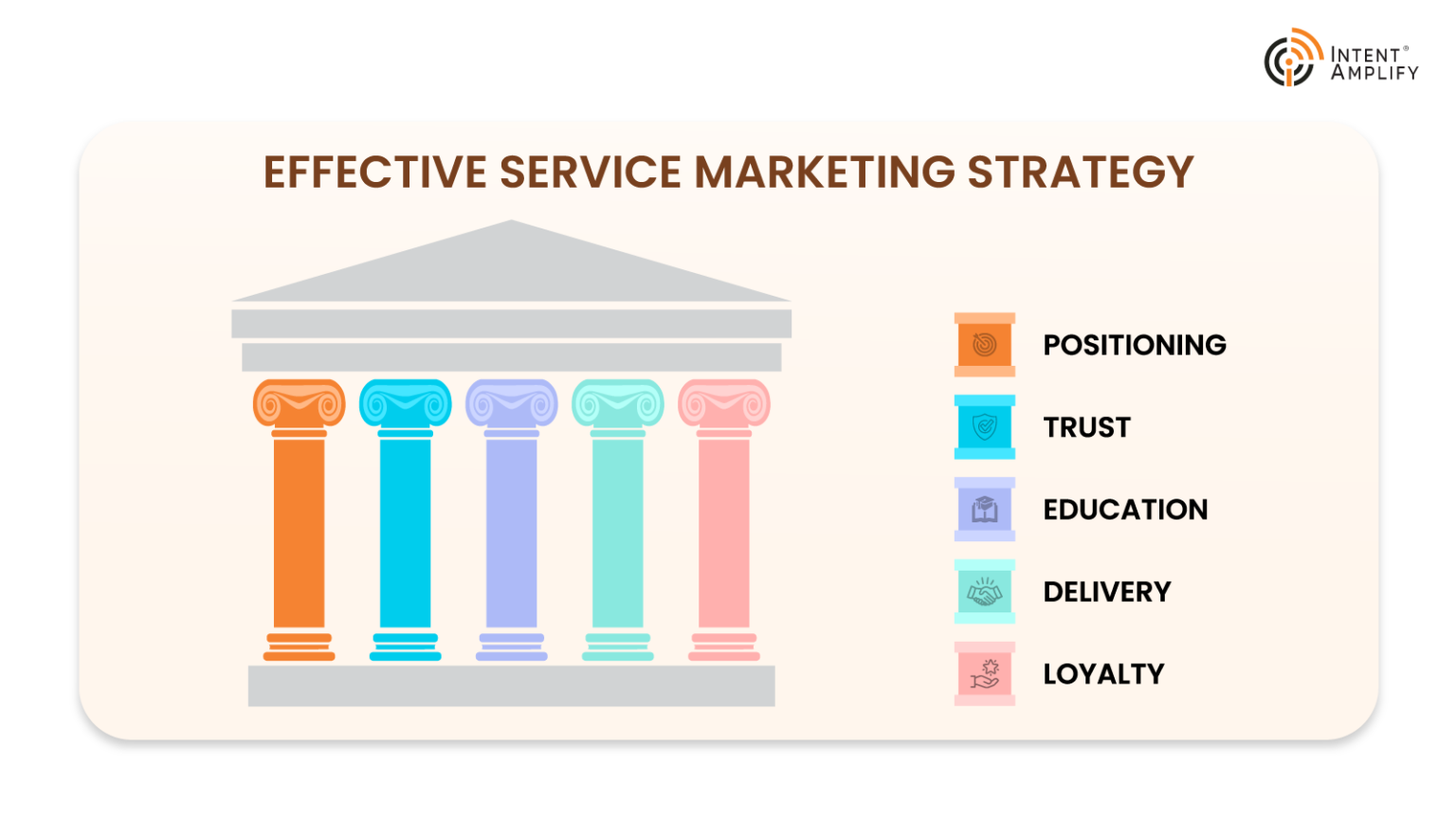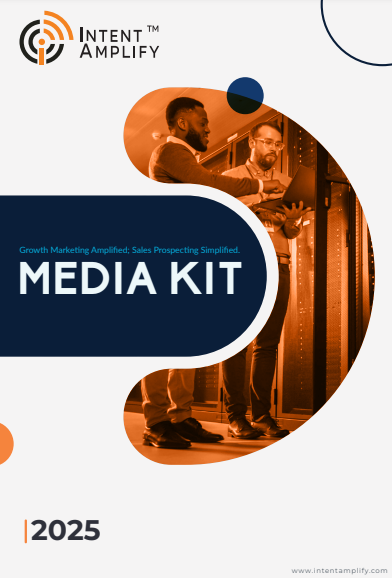
What Is Service Marketing in 2025? A Practical Guide for B2B Marketers
- Last updated on: July 15, 2025
In 2025, buyers will trust a brand’s content 3x more than a sales rep.” – Edelman Trust Barometer. That changes the game. If you’re marketing a B2B service, your content isn’t just supporting the main act. Your prospects are watching, judging, and deciding – all without filling out a form or booking a demo. They want proof, not promises. They want relevance, not reach.
And we know services are harder to sell. You’re not showing a product – you’re selling a process, a result, a belief that your team can deliver something invisible but mission-critical. That’s why service marketing in 2025 must be sharp, specific, and buyer-led. Just plain value, conveyed with confidence, at every touch point. In this article, we will dissect exactly how leading B2B brands are succeeding with service marketing in 2025 and how you can accomplish the same.
What Is Service Marketing in 2025?
At Intent Amplify, we define Service marketing as the processes, tools, and strategies companies employ to market and sell intangible products, like consulting, software, or professional services. In 2025, it’s come a long way from brochures and cold calls. Now, service marketing is all about choreographing a smooth, end-to-end customer experience that conveys trust, addresses problems, and fosters lasting relationships.
For B2B companies, this means aligning marketing, sales, and customer success into one continuous loop. You’re not just explaining what your service does; you’re showing how it improves your client’s operations, enhances their reputation, or scales their revenue. Everything from your website copy to your onboarding emails is part of your service marketing.
And since services are intangible, the emotional cues, case studies, promises, and value messaging you use become the “product” buyers evaluate. Service marketing in 2025 is about being transparent, consultative, and consistently helpful in every interaction.
Why B2B Service Marketing Requires a Different Mindset?
Selling services isn’t the same as selling software licenses or equipment. There’s no physical product to demo, no clear-cut specs to compare. That’s why B2B service marketing in 2025 demands a relationship-driven mindset.
Let’s break it down. When a B2B buyer considers a service, they’re asking:
- Will this solve my pain points?
- Will this partner deliver on promises?
- Will I get real ROI from this?
Your job is to answer these silently asked questions upfront. That requires building credibility, clarity, and continuity. Every piece of marketing content – be it a case study, email, or LinkedIn post – should make the buyer feel, “These folks understand my problem better than I do.”
More than that, your marketing must educate, reassure, and lead. B2B service buyers don’t want to be sold to – they want to be advised. So your approach has to shift from promotion to partnership. That’s what separates average B2B marketing from service marketing that converts in 2025.
Key Pillars of an Effective Service Marketing Strategy
An effective service marketing strategy stands on five key pillars: positioning, trust, education, delivery, and loyalty. Let’s unpack each:
- Positioning: You must clearly define what you solve, for whom, and how you’re different. Generic value props won’t cut it in 2025. Tailor your messaging to real industries and real challenges.
- Trust: Without a physical product, trust is everything. Reviews, testimonials, case studies, and social proof should be woven into every touchpoint.
- Education: Since services can be abstract, education bridges the gap. Think ebooks, videos, webinars, and live demos that simplify complex offerings.
- Delivery Experience: Your marketing should never overpromise what your service team can’t deliver. Alignment across marketing and delivery is key.
- Loyalty: Don’t stop marketing post-sale. Use client success stories, feedback loops, and personalized retention campaigns to turn buyers into brand advocates.
When these pillars are in sync, your service marketing becomes a growth engine, not just a support function.
Digital Trends Transforming Service Marketing in 2025
In 2025, several digital trends are reshaping how B2B service providers engage with prospects. First, voice search and AI chatbots are changing discovery. Buyers are using conversational queries like “What’s the best cybersecurity service for fintech?” – so your content must be optimized for intent-based search.
Second, interactive content – like calculators, diagnostic quizzes, or virtual walkthroughs – is replacing static brochures. Today’s B2B buyer expects experiences, not just explanations.
Third, zero-click platforms like LinkedIn, Google SERPs, and YouTube Shorts are making it harder to bring traffic back to your site. That’s why your messaging must land hard even when you don’t own the platform.
And finally, AI-generated but human-verified content is rising. Marketers are leveraging AI for scale, but human insight is what earns trust. So in 2025, your content must be efficient, accurate, and unmistakably human in tone. Ignore these trends, and you risk falling behind in a market where attention is currency.
The Role of AI, Automation & Personalization
In 2025, AI isn’t just a tool – it’s your silent marketing assistant. B2B service marketers are now using AI to power predictive segmentation, smart personalization, and automated content creation at scale.
Want to send a proposal follow-up tailored to a CFO vs. a CTO? AI knows the difference. Want to understand when your prospect is ready for a call? Predictive intent signals powered by AI show you the right timing.
But automation must never feel robotic. Successful service marketing uses AI to augment human connection, not replace it. For instance, AI might draft a nurture sequence, but a marketer personalizes the final message using account-level insights.
The real win in 2025 lies in using automation for scale and personalization for depth. That blend allows B2B teams to deliver the right message, at the right time, in the right voice, without burning out.
Understanding the B2B Buyer Journey Today
The B2B buyer journey in 2025 is non-linear, highly informed, and digital-first. On average, decision-makers consume 6 to 10 pieces of content before ever filling out a contact form. They self-educate, compare, verify, and even test solutions before interacting with a sales rep.
Your job in service marketing? Be everywhere they’re looking and speak to each stage of their journey:
- Awareness: Highlight problems your audience might not even realize they have. Use thought leadership and industry insights to grab attention.
- Consideration: Offer solution-based content like comparisons, webinars, or ROI calculators that clarify the benefits of your service.
- Decision: Now is the time for demos, case studies, and pricing guides. This content should reinforce trust and eliminate doubt.
Don’t assume people will follow your funnel in order. In 2025, your content must work in any sequence, across devices and platforms.
Crafting a Service Promise That Builds Trust
In product marketing, buyers judge features. In service marketing, they judge promises. That makes your service promise your brand’s commitment to outcomes an essential tool.
Your service promise should be:
- Specific (e.g., “We reduce lead response times by 50% in 90 days”)
- Verifiable (supported by client results or benchmarks)
- Deliverable (aligned with your actual capabilities)
Avoid vague, marketing-heavy slogans. Instead, state what you do, who it’s for, and what value they can realistically expect.
Also, make sure the customer experience matches the promise. In 2025, a misaligned promise is a viral LinkedIn post waiting to happen. B2B buyers share bad experiences faster than ever. So be bold, but be honest. A strong service promise can shorten sales cycles and convert skeptical buyers, especially in a saturated marketplace.
How to Market Intangible Value?
Marketing services mean selling something you can’t hold, touch, or try before you buy. That’s why intangible value needs to be made tangible through your storytelling.
Use the following strategies in 2025:
- Client transformations: Don’t just talk about outcomes—show them. Use before-and-after narratives that highlight measurable success.
- Expert voices: Let your team’s knowledge shine. Blog posts, LinkedIn content, and client Q&As create visible authority.
- Process visualization: Turn your service process into a branded framework or roadmap. This adds structure to what can feel abstract.
- Emotional cues: People buy services based on trust and emotion, even in B2B. Use testimonials and tone to make your brand feel human and confident.
The more you clarify the “how” and “why” behind your service, the easier it becomes for buyers to say yes, even when they can’t see the deliverable.
Metrics That Matter in Measuring Service Marketing ROI
In 2025, vanity metrics are out. B2B leaders want impact-proof ROI from marketing, especially for services.
Here’s what you should track:
- Marketing Sourced Pipeline: How much revenue originated from your campaigns?
- Conversion Rate by Content Type: Which content moves deals forward?
- Customer Lifetime Value (CLTV): Are you attracting clients who stay and scale?
- Net Promoter Score (NPS): Are your clients advocates or churn risks?
- Lead Velocity Rate (LVR): Are you growing the number of qualified leads month over month?
Also, use attribution modeling tools to trace influence across the journey, from ad click to contract signed. For B2B services, long sales cycles can make ROI harder to track. That’s why it’s essential to use a mix of first-party intent data and CRM analytics to get the full picture.
Common Mistakes to Avoid in 2025
Even the best B2B teams fall into avoidable traps. Here are the top mistakes service marketers must avoid this year:
- Overpromising in Messaging: Your claims must reflect reality. Buyers in 2025 verify everything.
- Ignoring Post-Sale Marketing: Marketing doesn’t stop at close. Use upsell, cross-sell, and loyalty campaigns.
- Generic Content: Service marketing thrives on specificity. “Solutions for all” converts no one.
- Underinvesting in Content Design: Great content needs great design, especially with zero-click trends rising.
- Treating AI as a Shortcut: Don’t fully automate. Human oversight is still critical for tone, empathy, and strategy.
In 2025, service marketing is all about precision and credibility. Avoid shortcuts and take a buyer-first approach at every stage.
Turn Your Team into Influencers: Why Personal Branding Matters
Here’s a truth about 2025: B2B buyers trust people, not logos. That’s why personal branding has become a secret weapon in service marketing. When your team members—consultants, strategists, marketers share insights online, they’re doing more than posting; they’re building authentic trust for your brand.
Encourage your experts to be visible on platforms like LinkedIn. Let them talk about client problems they’ve solved, their take on market trends, or what sets your service apart. This human-first marketing adds a layer of relatability and credibility no campaign can replicate.
You can also formalize an employee advocacy program using tools like EveryoneSocial. These amplify branded content through employee voices, dramatically increasing your reach and relevance. In 2025, your smartest service marketing move might be getting your smartest people to speak up. Let them build their brand, and yours will grow too.
Speak Their Language: Industry-Specific Messaging That Works
Your service may be flexible, but your messaging shouldn’t be. B2B decision-makers in 2025 expect marketing that reflects their unique industry context, pain points, and regulations. That’s why vertical-specific positioning isn’t optional – it’s essential.
Create tailored landing pages, email sequences, and content assets for each key sector you serve. Whether it’s legal, healthcare, fintech, or manufacturing, use the language they speak and address challenges they face. This makes your service feel like it was designed just for them.
Localization also matters. A CFO in Texas may expect a different tone or compliance assurance than one in New York or Toronto. Adapt tone, formats, and messaging to regional nuances whenever possible. When buyers feel seen and understood, they’re more likely to trust and buy. That’s what industry-specific service marketing delivers: faster trust and fewer objections.
How Intent Amplify Helps You Win With Service Marketing
At Intent Amplify, we help B2B companies turn their service offerings into scalable, revenue-generating growth engines. Our approach to service marketing in 2025 is designed to help you:
- Define a clear value proposition that speaks directly to your buyers’ needs
- Build trust across the funnel with compelling content, case studies, and personalization
- Use smart outreach and automation to nurture leads without sounding robotic
- Create post-sale engagement flows that retain clients and boost lifetime value
We know what works, and we help you implement it without the guesswork. From appointment setting to full-funnel content strategies, we bring the systems, tools, and expertise your service brand needs to stand out and scale.
FAQs
1. What is the main difference between product and service marketing?
Product marketing focuses on selling tangible goods, while service marketing emphasizes building trust, communicating value, and creating experiences around intangible offerings like consulting or SaaS.
Why is service marketing important for B2B brands in 2025?
Because B2B buyers are more informed and selective. Service marketing helps brands establish authority, guide buyers through complex decisions, and build long-term loyalty.
How do I make my service marketing strategy stand out?
Focus on buyer pain points, use real proof like case studies, and deliver personalized experiences. Avoid generic claims and always align your promise with delivery.
What platforms work best for B2B service marketing?
LinkedIn, your website, email sequences, and YouTube remain core. Podcasts and gated resources also drive deep engagement with decision-makers.
Can AI replace human-led service marketing?
No, but it can supercharge it. Use AI for personalization, segmentation, and insights. Keep human creativity and empathy at the core of your messaging.






